Abstract
Bisphosphonates are generally considered to act on bone resorption by binding to bone mineral and subsequently inhibiting the activity of the osteoclasts which ingest them. This has been supported by the fact that bisphosphonates adsorbed on mineralized tissue inhibit the resorbing activity of isolated osteoclasts in vitro. However, the effectiveness of different bisphosphonates determined in this system does not reflect their relative potencies in vivo. Employing the well-described isolated osteoclast resorption pit assay, with ivory as the resorption substrate, we show here that this lack of correlation prevails only when the bisphosphonates are added to the mineral before addition of osteoclasts, but not when the cells are treated for a short time (5 min) before allowing them to adhere onto ivory. By using this approach with five different bisphosphonates, a stringent correlation of relative potencies was obtained with those found, both in the rat and in the human, in vivo. Furthermore, by using an osteoblastic cell line (CRP 10/30) which is a powerful promoter of osteoclastic resorption in vitro, we obtained evidence that the inhibitory effect of bisphosphonates was the result of an action on osteoblasts rather than on osteoclasts. Thus, in experiments in which the osteoblastic cells were pretreated for 5 min with bisphosphonates and then cocultured with osteoclasts, inhibition of osteoclastic resorbing activity was obtained. Moreover, it was found that this treatment resulted in a decrease of the stimulatory effect found in CRP 10/30-conditioned medium. In conclusion the present study shows that part of the osteoclast inhibiting action of the bisphosphonates is mediated through an action on osteoblasts.
Full text
PDF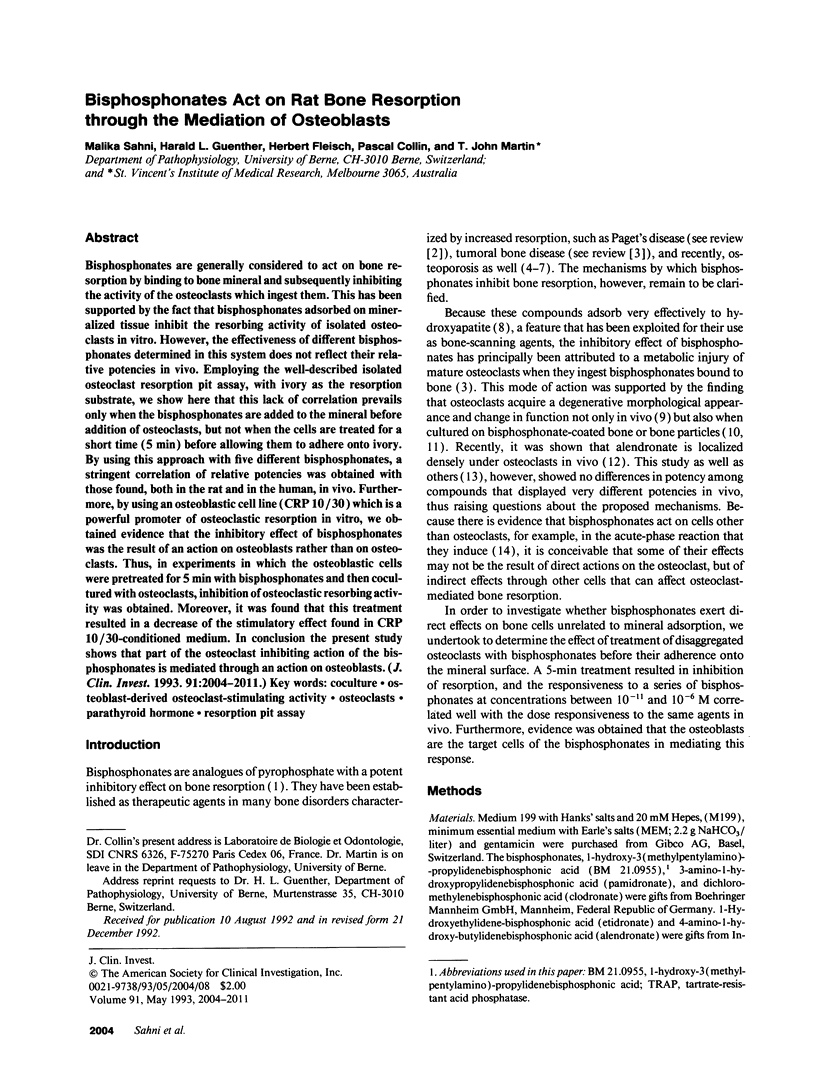
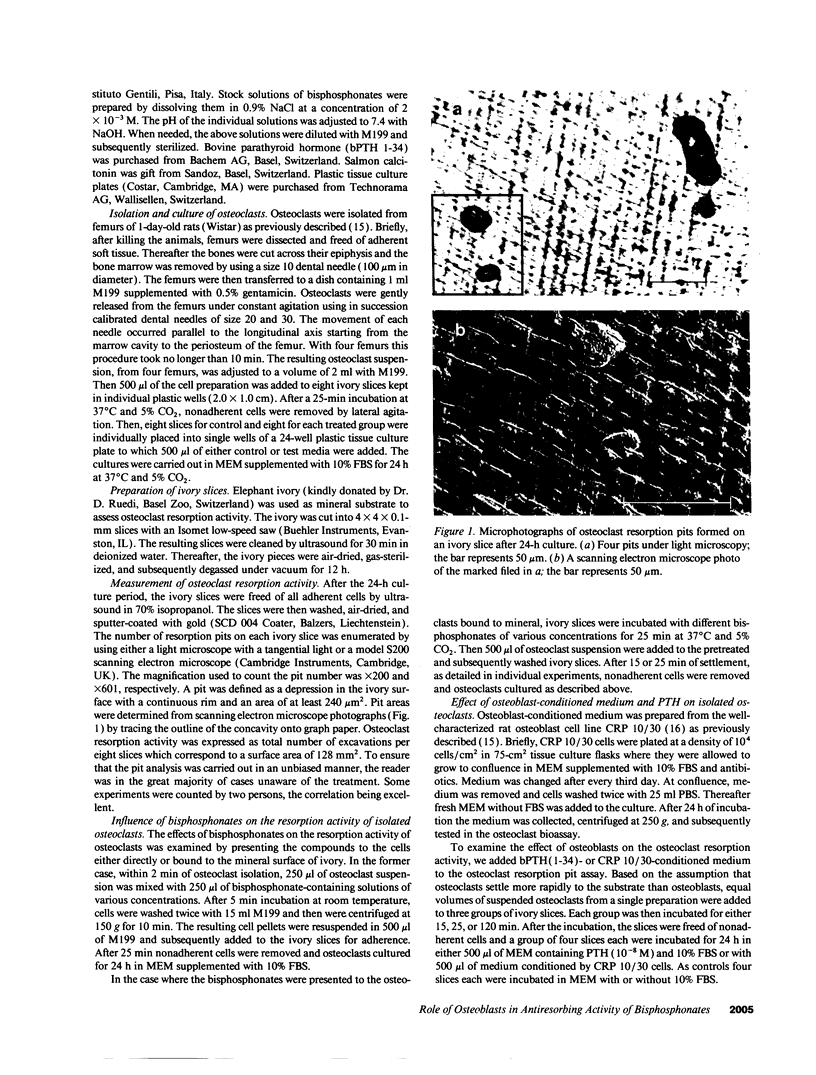
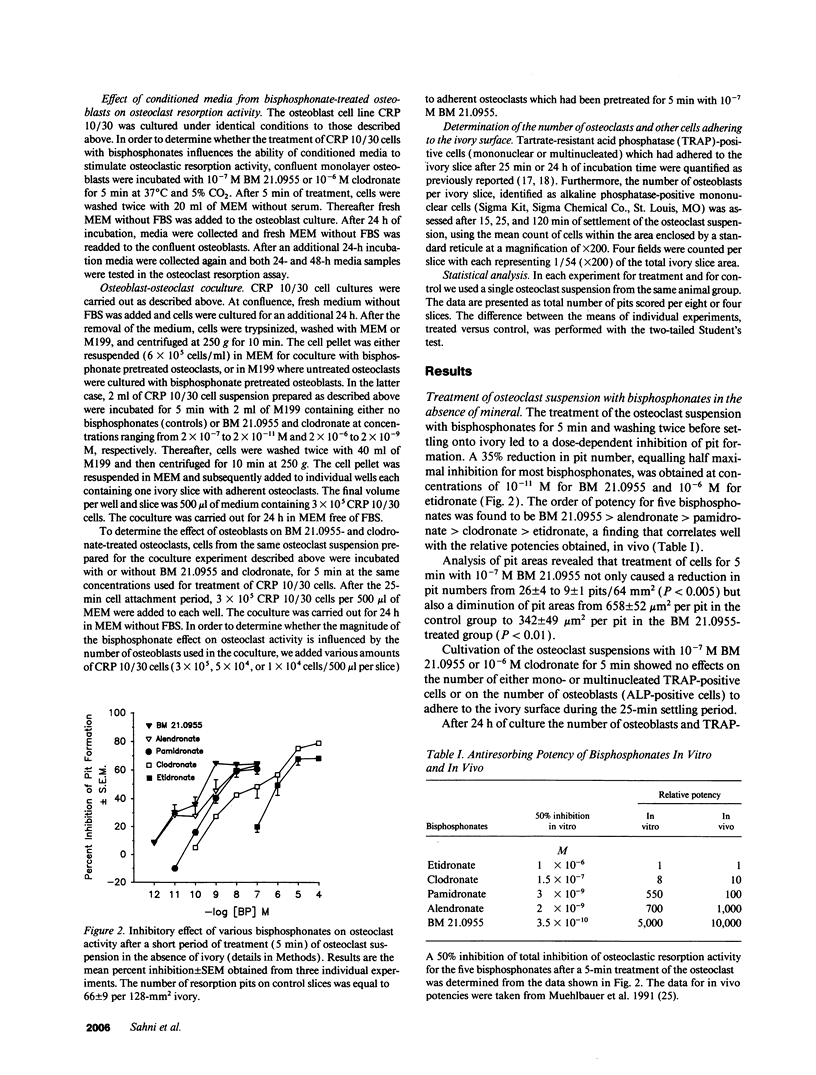
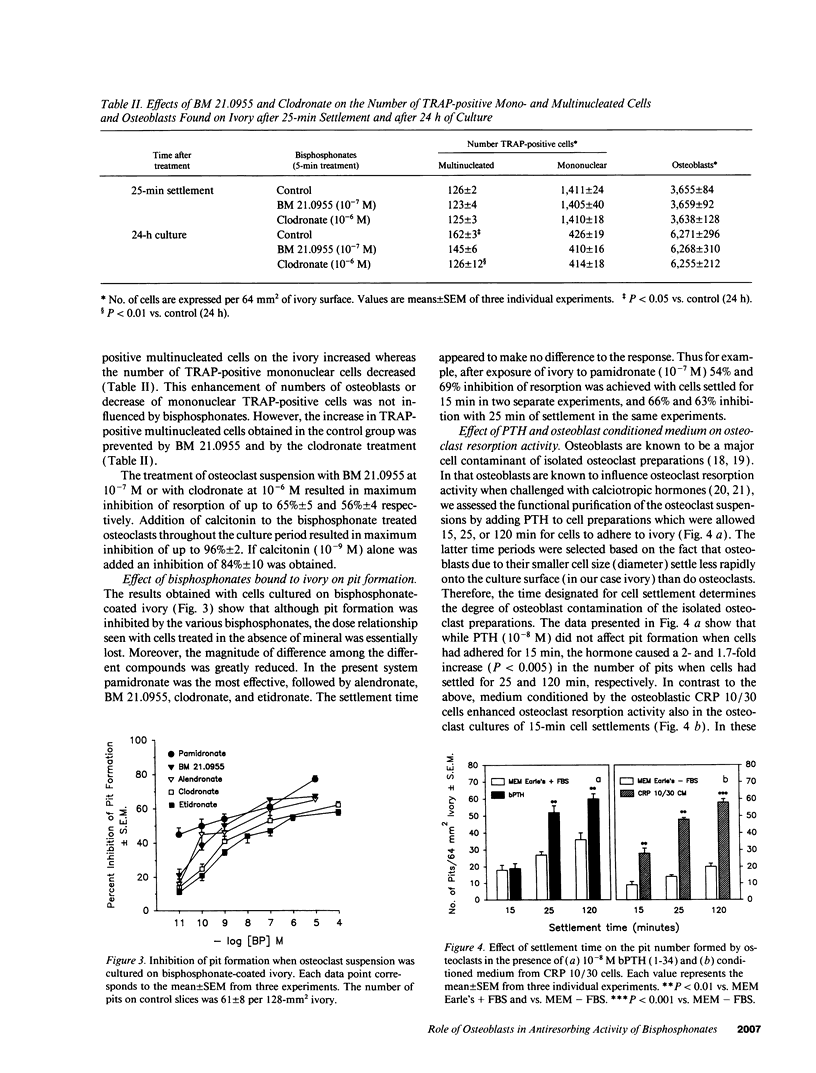
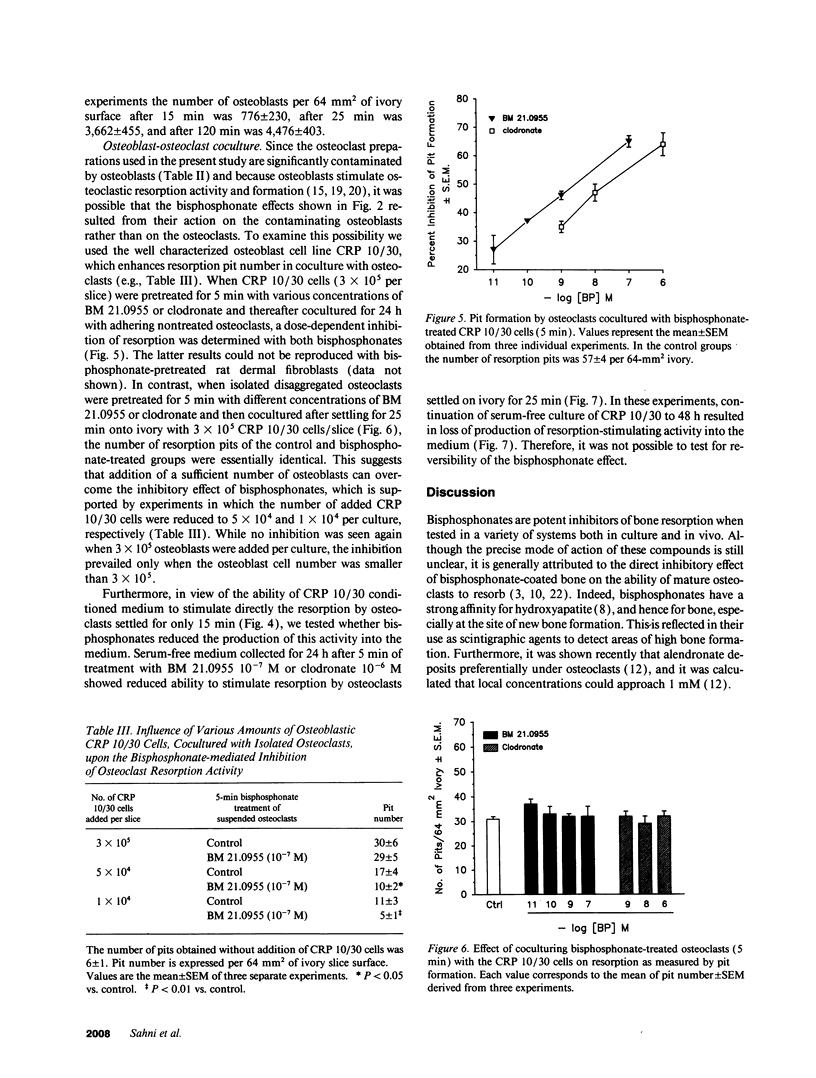
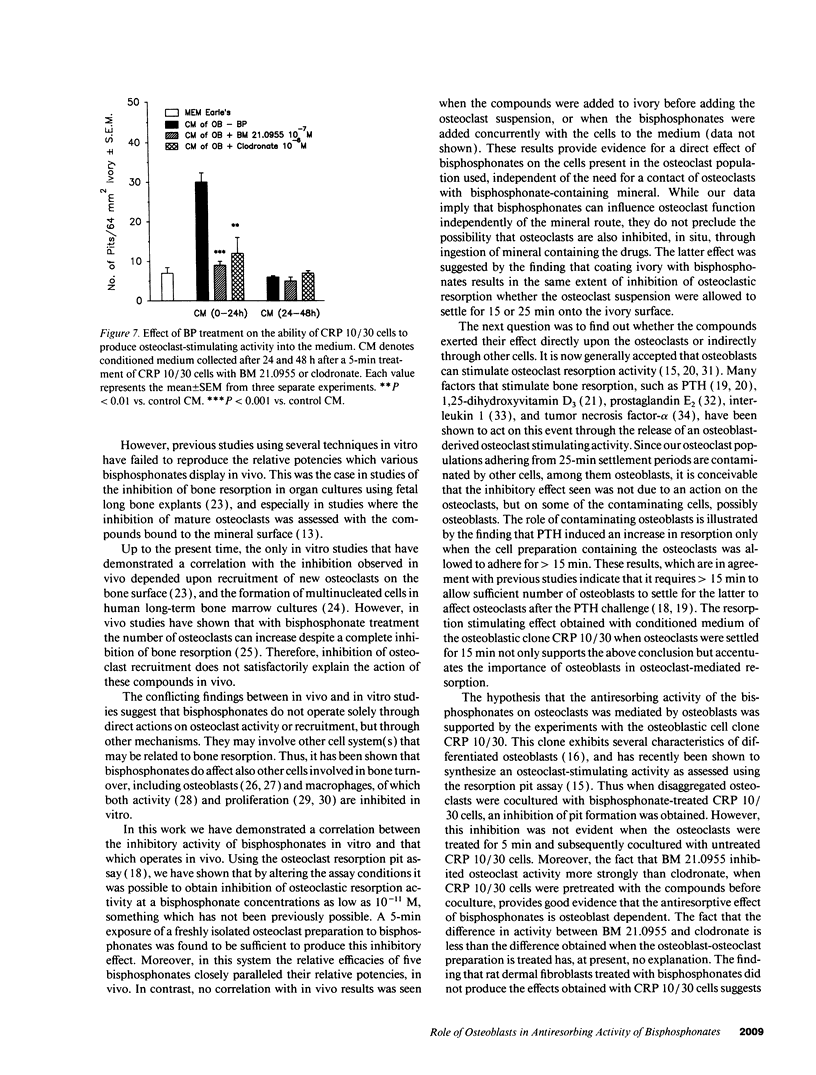
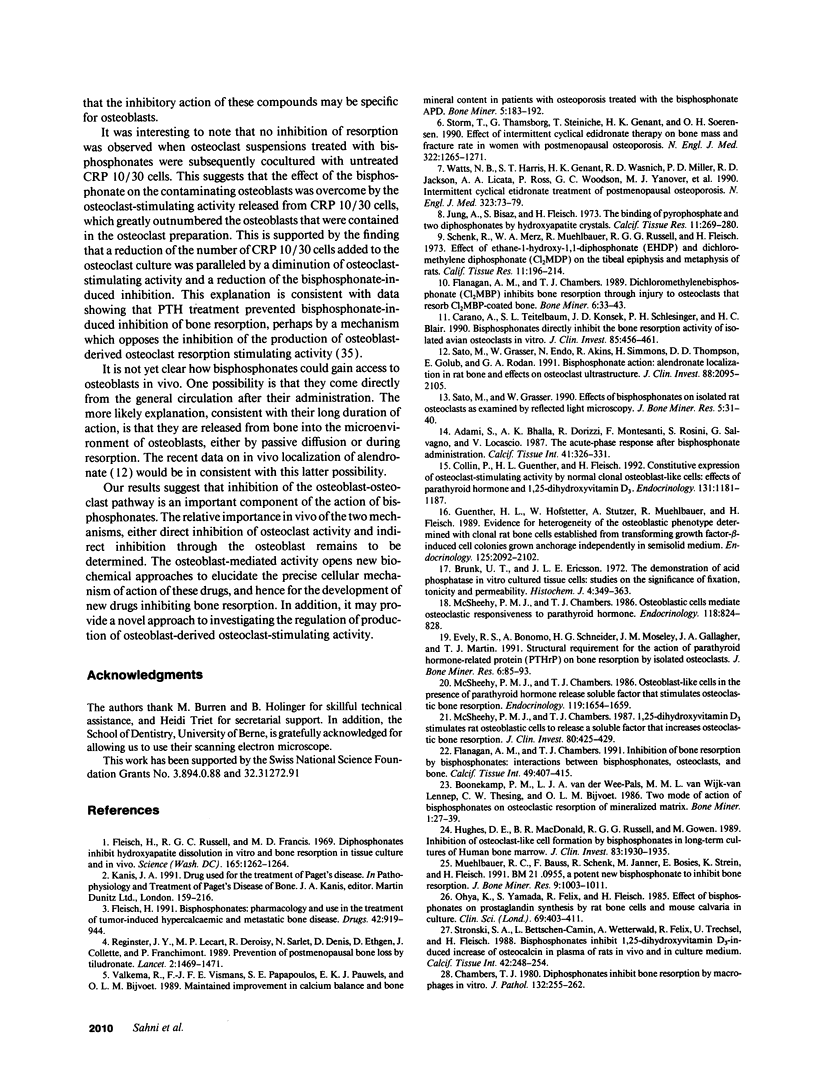

Images in this article
Selected References
These references are in PubMed. This may not be the complete list of references from this article.
- Adami S., Bhalla A. K., Dorizzi R., Montesanti F., Rosini S., Salvagno G., Lo Cascio V. The acute-phase response after bisphosphonate administration. Calcif Tissue Int. 1987 Dec;41(6):326–331. doi: 10.1007/BF02556671. [DOI] [PubMed] [Google Scholar]
- Boonekamp P. M., van der Wee-Pals L. J., van Wijk-van Lennep M. M., Thesing C. W., Bijvoet O. L. Two modes of action of bisphosphonates on osteoclastic resorption of mineralized matrix. Bone Miner. 1986 Feb;1(1):27–39. [PubMed] [Google Scholar]
- Brunk U. T., Ericsson J. L. The demonstration of acid phosphatase in vitro cultured tissue cells. Studies on the significance of fixation, tonicity and permeability. Histochem J. 1972 Jul;4(4):349–363. doi: 10.1007/BF01005009. [DOI] [PubMed] [Google Scholar]
- Carano A., Teitelbaum S. L., Konsek J. D., Schlesinger P. H., Blair H. C. Bisphosphonates directly inhibit the bone resorption activity of isolated avian osteoclasts in vitro. J Clin Invest. 1990 Feb;85(2):456–461. doi: 10.1172/JCI114459. [DOI] [PMC free article] [PubMed] [Google Scholar]
- Cecchini M. G., Felix R., Fleisch H., Cooper P. H. Effect of bisphosphonates on proliferation and viability of mouse bone marrow-derived macrophages. J Bone Miner Res. 1987 Apr;2(2):135–142. doi: 10.1002/jbmr.5650020209. [DOI] [PubMed] [Google Scholar]
- Cecchini M. G., Fleisch H. Bisphosphonates in vitro specifically inhibit, among the hematopoietic series, the development of the mouse mononuclear phagocyte lineage. J Bone Miner Res. 1990 Oct;5(10):1019–1027. doi: 10.1002/jbmr.5650051005. [DOI] [PubMed] [Google Scholar]
- Chambers T. J. Diphosphonates inhibit bone resorption by macrophages in vitro. J Pathol. 1980 Nov;132(3):255–262. doi: 10.1002/path.1711320307. [DOI] [PubMed] [Google Scholar]
- Collin P., Guenther H. L., Fleisch H. Constitutive expression of osteoclast-stimulating activity by normal clonal osteoblast-like cells: effects of parathyroid hormone and 1,25-dihydroxyvitamin D3. Endocrinology. 1992 Sep;131(3):1181–1187. doi: 10.1210/endo.131.3.1505460. [DOI] [PubMed] [Google Scholar]
- Evely R. S., Bonomo A., Schneider H. G., Moseley J. M., Gallagher J., Martin T. J. Structural requirements for the action of parathyroid hormone-related protein (PTHrP) on bone resorption by isolated osteoclasts. J Bone Miner Res. 1991 Jan;6(1):85–93. doi: 10.1002/jbmr.5650060114. [DOI] [PubMed] [Google Scholar]
- Flanagan A. M., Chambers T. J. Inhibition of bone resorption by bisphosphonates: interactions between bisphosphonates, osteoclasts, and bone. Calcif Tissue Int. 1991 Dec;49(6):407–415. doi: 10.1007/BF02555852. [DOI] [PubMed] [Google Scholar]
- Fleisch H. Bisphosphonates. Pharmacology and use in the treatment of tumour-induced hypercalcaemic and metastatic bone disease. Drugs. 1991 Dec;42(6):919–944. doi: 10.2165/00003495-199142060-00003. [DOI] [PubMed] [Google Scholar]
- Fleisch H., Russell R. G., Francis M. D. Diphosphonates inhibit hydroxyapatite dissolution in vitro and bone resorption in tissue culture and in vivo. Science. 1969 Sep 19;165(3899):1262–1264. doi: 10.1126/science.165.3899.1262. [DOI] [PubMed] [Google Scholar]
- Guenther H. L., Hofstetter W., Stutzer A., Mühlbauer R., Fleisch H. Evidence for heterogeneity of the osteoblastic phenotype determined with clonal rat bone cells established from transforming growth factor-beta-induced cell colonies grown anchorage independently in semisolid medium. Endocrinology. 1989 Oct;125(4):2092–2102. doi: 10.1210/endo-125-4-2092. [DOI] [PubMed] [Google Scholar]
- Hughes D. E., MacDonald B. R., Russell R. G., Gowen M. Inhibition of osteoclast-like cell formation by bisphosphonates in long-term cultures of human bone marrow. J Clin Invest. 1989 Jun;83(6):1930–1935. doi: 10.1172/JCI114100. [DOI] [PMC free article] [PubMed] [Google Scholar]
- Jung A., Bisaz S., Fleisch H. The binding of pyrophosphate and two diphosphonates by hydroxyapatite crystals. Calcif Tissue Res. 1973 Mar 30;11(4):269–280. doi: 10.1007/BF02547227. [DOI] [PubMed] [Google Scholar]
- McSheehy P. M., Chambers T. J. 1,25-Dihydroxyvitamin D3 stimulates rat osteoblastic cells to release a soluble factor that increases osteoclastic bone resorption. J Clin Invest. 1987 Aug;80(2):425–429. doi: 10.1172/JCI113089. [DOI] [PMC free article] [PubMed] [Google Scholar]
- McSheehy P. M., Chambers T. J. Osteoblast-like cells in the presence of parathyroid hormone release soluble factor that stimulates osteoclastic bone resorption. Endocrinology. 1986 Oct;119(4):1654–1659. doi: 10.1210/endo-119-4-1654. [DOI] [PubMed] [Google Scholar]
- McSheehy P. M., Chambers T. J. Osteoblastic cells mediate osteoclastic responsiveness to parathyroid hormone. Endocrinology. 1986 Feb;118(2):824–828. doi: 10.1210/endo-118-2-824. [DOI] [PubMed] [Google Scholar]
- Mühlbauer R. C., Bauss F., Schenk R., Janner M., Bosies E., Strein K., Fleisch H. BM 21.0955, a potent new bisphosphonate to inhibit bone resorption. J Bone Miner Res. 1991 Sep;6(9):1003–1011. doi: 10.1002/jbmr.5650060915. [DOI] [PubMed] [Google Scholar]
- Okuda A., Taylor L. M., Heersche J. N. Prostaglandin E2 initially inhibits and then stimulates bone resorption in isolated rabbit osteoclast cultures. Bone Miner. 1989 Nov;7(3):255–266. doi: 10.1016/0169-6009(89)90082-2. [DOI] [PubMed] [Google Scholar]
- Reginster J. Y., Lecart M. P., Deroisy R., Sarlet N., Denis D., Ethgen D., Collette J., Franchimont P. Prevention of postmenopausal bone loss by tiludronate. Lancet. 1989 Dec 23;2(8678-8679):1469–1471. doi: 10.1016/s0140-6736(89)92927-9. [DOI] [PubMed] [Google Scholar]
- Rodan G. A., Martin T. J. Role of osteoblasts in hormonal control of bone resorption--a hypothesis. Calcif Tissue Int. 1981;33(4):349–351. doi: 10.1007/BF02409454. [DOI] [PubMed] [Google Scholar]
- Sato M., Grasser W. Effects of bisphosphonates on isolated rat osteoclasts as examined by reflected light microscopy. J Bone Miner Res. 1990 Jan;5(1):31–40. doi: 10.1002/jbmr.5650050107. [DOI] [PubMed] [Google Scholar]
- Sato M., Grasser W., Endo N., Akins R., Simmons H., Thompson D. D., Golub E., Rodan G. A. Bisphosphonate action. Alendronate localization in rat bone and effects on osteoclast ultrastructure. J Clin Invest. 1991 Dec;88(6):2095–2105. doi: 10.1172/JCI115539. [DOI] [PMC free article] [PubMed] [Google Scholar]
- Schenk R., Merz W. A., Mühlbauer R., Russell R. G., Fleisch H. Effect of ethane-1-hydroxy-1,1-diphosphonate (EHDP) and dichloromethylene diphosphonate (Cl 2 MDP) on the calcification and resorption of cartilage and bone in the tibial epiphysis and metaphysis of rats. Calcif Tissue Res. 1973 Mar 12;11(3):196–214. doi: 10.1007/BF02547219. [DOI] [PubMed] [Google Scholar]
- Storm T., Thamsborg G., Steiniche T., Genant H. K., Sørensen O. H. Effect of intermittent cyclical etidronate therapy on bone mass and fracture rate in women with postmenopausal osteoporosis. N Engl J Med. 1990 May 3;322(18):1265–1271. doi: 10.1056/NEJM199005033221803. [DOI] [PubMed] [Google Scholar]
- Stronski S. A., Bettschen-Camin L., Wetterwald A., Felix R., Trechsel U., Fleisch H. Bisphosphonates inhibit 1,25-dihydroxyvitamin D3-induced increase of osteocalcin in plasma of rats in vivo and in culture medium of rat calvaria in vitro. Calcif Tissue Int. 1988 Apr;42(4):248–254. doi: 10.1007/BF02553751. [DOI] [PubMed] [Google Scholar]
- Thomson B. M., Mundy G. R., Chambers T. J. Tumor necrosis factors alpha and beta induce osteoblastic cells to stimulate osteoclastic bone resorption. J Immunol. 1987 Feb 1;138(3):775–779. [PubMed] [Google Scholar]
- Thomson B. M., Saklatvala J., Chambers T. J. Osteoblasts mediate interleukin 1 stimulation of bone resorption by rat osteoclasts. J Exp Med. 1986 Jul 1;164(1):104–112. doi: 10.1084/jem.164.1.104. [DOI] [PMC free article] [PubMed] [Google Scholar]
- Valkema R., Vismans F. J., Papapoulos S. E., Pauwels E. K., Bijvoet O. L. Maintained improvement in calcium balance and bone mineral content in patients with osteoporosis treated with the bisphosphonate APD. Bone Miner. 1989 Jan;5(2):183–192. doi: 10.1016/0169-6009(89)90095-0. [DOI] [PubMed] [Google Scholar]
- Watts N. B., Harris S. T., Genant H. K., Wasnich R. D., Miller P. D., Jackson R. D., Licata A. A., Ross P., Woodson G. C., 3rd, Yanover M. J. Intermittent cyclical etidronate treatment of postmenopausal osteoporosis. N Engl J Med. 1990 Jul 12;323(2):73–79. doi: 10.1056/NEJM199007123230201. [DOI] [PubMed] [Google Scholar]
- van der Pluijm G., Löwik C. W., de Groot H., Alblas M. J., van der Wee-Pals L. J., Bijvoet O. L., Papapoulos S. E. Modulation of PTH-stimulated osteoclastic resorption by bisphosphonates in fetal mouse bone explants. J Bone Miner Res. 1991 Nov;6(11):1203–1210. doi: 10.1002/jbmr.5650061110. [DOI] [PubMed] [Google Scholar]




